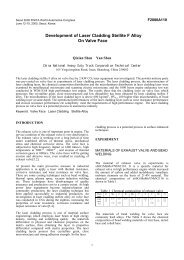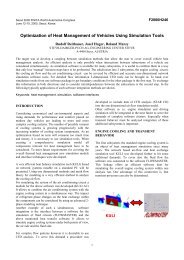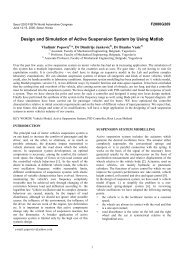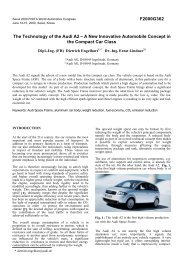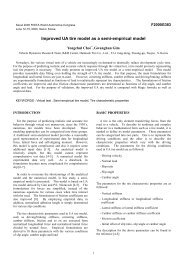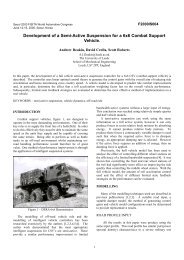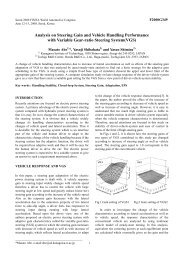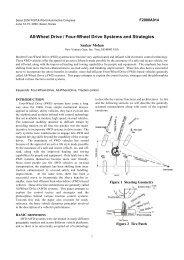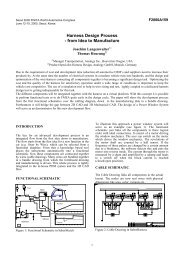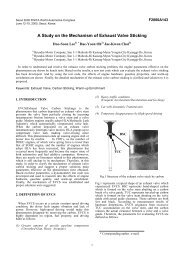The aXcessaustralia Hybrid Electric Car Project
The aXcessaustralia Hybrid Electric Car Project
The aXcessaustralia Hybrid Electric Car Project
Create successful ePaper yourself
Turn your PDF publications into a flip-book with our unique Google optimized e-Paper software.
and will continue to do so. Fuel consumption issufficiently good to fulfil the needs of most users attoday’s fuel prices, but rising fuel prices will provideincentive to pursue better fuel economy.Figure 4 shows alternative powertrain technologiesranked in terms of fuel economy. It shows thatsubstantial gains over the baseline car (representingtoday’s average new mass-production car) could be madeFigure 4: Fuel Consumption Comparison(m.p.g.)MinMaxBaseline carLightweight body carDiesel Direct injectionSeries hybrid - gasolineParallel hybrid - dieselSeries hybrid - dieselFuel cell - onboard reformerFuel Cell - direct hydrogen0 20 40 60 80 100D iff.G e a rb o xElec. M otor/G e n e ra to rClutchIC Enginesmaller as it only needs to handle the supplemental power.In a Series configuration the internal combustion engine(ESU) is not connected to the wheels. It is used only todrive the generator, which delivers its power to the drivemotor or to the Surge Power Unit.<strong>The</strong> job of the SPU is to supplement the energy availablefrom the Energy Supply Unit so that the total energyrequirement can be met as quickly as necessary.Diff.ElectronicsSPUBatteryFigure 5: Parallel <strong>Hybrid</strong>-<strong>Electric</strong> Configurationby using lightweight materials in car construction andalso by using diesel direct-injection technology. Furtherimprovements are possible by changing to electric orhybrid-electric drive trains. <strong>The</strong> ultimate seems to be afuel-cell, but until the fuel cell becomes available at anaffordable cost, hybrid-electric alternatives present anattractive option.<strong>Electric</strong> Motor/GeneratorElectronicsBatteries/SPU<strong>Hybrid</strong> powertrains offer significant improvements infuel consumption as compared with today’s car and withthe added promise of 90% reduction in pollution.ALTERNATIVE HYBRID-ELECTRICPOWERTRAIN CONFIGURATIONSVehicles with conventional internal combustion engine(Energy Supply Unit) and an energy storage device(Surge Power Unit) are known as <strong>Hybrid</strong> <strong>Electric</strong>Vehicles because they use energy from both petrol andelectrical storage to propel the vehicle.<strong>The</strong> two basic types of hybrid-electric configuration areknown as Parallel and Series. A Parallel arrangementmeans that the internal combustion engine can drive thewheels directly and the surge power unit can provideextra power when required. <strong>The</strong> advantage of thisarrangement is that the <strong>Electric</strong> Traction Motor can beElectronicsGeneratorIC EngineSeries <strong>Hybrid</strong>-<strong>Electric</strong> ConfigurationToyota Motor Corporation launched the world’s firstproduction model hybrid-electric car at the end of 1997and has been producing around 2000 cars per month.After two years in production, the car has proved itsengineering excellence. However, <strong>The</strong> choice of nickelmetal-hydridebatteries seems to demonstrate the powerstorage dilemma.David Lamb3
Australian carmakers and component manufacturers havelearned to survive on small volumes that would not beeconomical in most countries. It is true that for decadesthe industry was protected by high import tariffs, but it isnonetheless a remarkable achievement that, with verysubstantially reduced tariffs, Australian automotiveindustry exports have reached more than $2.5 billion ayear.THE <strong>aXcessaustralia</strong> PROJECTSFigure 6: <strong>The</strong> Toyota Prius <strong>Hybrid</strong>-<strong>Electric</strong> <strong>Car</strong>When designing a hybrid electric car, engineers have hadto choose between a battery’s ability to store power andthe need to deliver a lot of power quickly.A normal car’s battery is almost always fully charged,because the alternator is generating power whenever theengine is operating. If a chemical battery has to copewith rapid and severe discharge, battery life is reducedsubstantially. <strong>The</strong> cost of replacing a battery pack canamount to half of the total operating cost of a hybridelectriccar.In February 1998 the first <strong>aXcessaustralia</strong> concept carwas shown to the global industry at the DetroitExposition of the Society of Automotive Engineers (seeFigure 7).<strong>The</strong> car attracted a great deal of interest because of itsunusual styling and its creative mix of features andtechnologies. As a vehicle to display Australianinnovation it was totally successful and helped Australiancomponent manufacturers on the way to $1 billion of newexport business. Its success provided a foundation for anew project to build a car to demonstrate that Australiahas the technology and the manufacturing capability tomake a low emissions car.<strong>The</strong> Australian Government, recognising the value ofretaining a viable industry, has joined with industry tofund a project to demonstrate Australian capabilities inmore advanced automotive technology.THE <strong>aXcessaustralia</strong> LOW EMISSIONVEHICLE PROJECT<strong>The</strong> <strong>aXcessaustralia</strong> low emission vehicle project isbased on technologies developed by CSIRO and 80component manufacturers. <strong>The</strong> project has been used tohelp industry in a novel way to show their technologicalcapabilities. It also helps companies learn about newautomotive technologies in general.Figure 7: <strong>aXcessaustralia</strong> Concept <strong>Car</strong> Mk 1AUSTRALIA’S HISTORY OF INNOVATIONAustralia has a rich automotive history. Large distancesand cars that had difficulty coping with rough, dry anddusty conditions, inspired Australians to be self-sufficientin adapting automotive technology to suit their needs.Australia is today one of no more than 10 countries thatcan style, design, engineer and manufacture almost everycomponent of the modern car. This is the reason whyAustralia manufactures a respectable proportion of thetotal cars sold, even though the market is less than800,000 vehicles.Companies whose traditional business has been tomanufacture components designed by carmakers have theopportunity to demonstrate their innovative skills on anexample of ‘tomorrow’s car’.Technologies used in today’s car are governed mostly bycost. <strong>The</strong> processes used in manufacturing today’s car arewell understood and result in a car that can be expected toperform reliably for several hundred thousand kilometresor more.Indeed, the reliability of cars can be problematical interms of pollution and emissions. Governmentsconsidering introduction of higher standards of emissioncompliance are usually reluctant to mandate for theremoval of older vehicles from the car pool. Greaterreliability in cars therefore makes the impact of new-carregulation take longer to reduce environmental damage.David Lamb4
NOVEL AUSTRALIAN POWERTRAINTECHNOLOGIESAustralia has several novel technologies that are suitablefor hybrid-electric cars. CSIRO has research programs inbatteries, electric motors, electrical power systemmanagement, and also supercapacitors. All these areas ofexpertise can be brought together in a creative approachto hybrid-electric propulsion and attract the interest of theglobal car industry as it moves towards the take-up ofelectric propulsion systems for cars.<strong>The</strong> <strong>aXcessaustralia</strong> car uses a novel, compact engine(ESU) to drive a generator in a Series hybridconfiguration. <strong>The</strong> Surge Power Unit comprises CSIROsupercapacitors and CSIRO batteries. <strong>The</strong> traction motoris a CSIRO water-cooled electric motor that also acts as agenerator when braking.During much of the operating time, power is suppliedfrom the batteries, supplemented by the supercapacitorsfor acceleration. <strong>The</strong> internal combustion enginegenerally operates in response to the needs of the storagesystem. However, for extreme power needs, all threesources of energy are available to the drive motorenabling vehicle performance to be equivalent to aconventional car.SUPERCAPACITORSSupercapacitors are used in telecommunications devices,but until now it has not been possible to expand thedevice to be used in high-power applications. CSIROdevelopedsupercapacitors use a carbon coating in anorganic electrolyte to form what is termed a ‘double layercapacitor’ (also referred to as a supercapacitor or an ultracapacitor).batteries results in a low cost and practicable SurgePower-Unit. Using an auxiliary energy store in the formof a 60-volt battery pack, the capacitor is only used forhigh power operation. <strong>The</strong> capacitor used in the<strong>aXcessaustralia</strong> car has been designed to efficientlydeliver up to 50 kW.BATTERIESBattery capacity and power delivery is improved by usingproprietary CSIRO chemistry and unique construction.<strong>The</strong> batteries are optimised for use in hybrid electricvehicles (HEVs) where they may spend considerable timepartially discharged, unlike the battery in a conventionalcar that is always charged by the alternator.<strong>The</strong> battery pack is subject to multiple charge−dischargecycles at high rates and is required to operate for manycycles below a full state-of-charge. Lead-acid isprobably the most cost-effective technology or use inmass-produced HEVs.CSIRO’s Novel Battery Technologies Group hasdeveloped a new design of valve-regulated lead-acidbattery specifically for use in HEVs. <strong>The</strong> new battery,called the Double-Impact, has current takeoffs at bothends of the positive and negative plates and has beenshown to significantly outperform state-of-the-artcommercial batteries under both HEV and electricvehicle (EV) conditions.Figure 9: <strong>The</strong> axcessaustralia Battery PackFigure 8: <strong>The</strong> <strong>aXcessaustralia</strong> supercapacitor packCSIRO technology delivers some of the highest capacityto-weightratios reported anywhere in the world and givesthe aXcess car a unique advantage compared with otherhybrids. Supercapacitors absorb energy and deliver storedenergy very quickly. Combining supercapacitors and<strong>The</strong> operating temperature of the double-impact batteryunder HEV and EV conditions is much reducedcompared to that of commercial equivalents. Thissimplifies the cooling requirements of the battery pack,improves system safety and reduces both degradation ofthe expander used in the negative plate and corrosion ofthe positive grid. Moreover, it minimises electrolytedryout, a condition that can increase the internalresistance of the battery and lead to problems with chargeacceptance later in life. <strong>The</strong> reduction in operatingtemperature can be attributed directly to the dual-tabdesign of the battery. In traditional units, which haveonly one current take-off or tab per plate, there is asignificant increase in current density, or ‘currentDavid Lamb5
concentration’, towards the tab during high-rate charge ordischarge. As heating within the battery is related to boththe square of the current and the resistance of the battery(i.e., Ι 2 R), high, localised current densities can result inlarge heating effects in these regions.<strong>The</strong> inclusion of a second current takeoff decreases thecurrent density at each tab and considerably reducesheating effects. <strong>The</strong> capacity and cycle-life under HEVand EV conditions is also much improved compared tocommercial designs. Once again, this is a direct result ofthe dual-tab design. Capacity increases are a result of thebattery plates operating at a uniform temperature, whichallows ‘even active-material utilisation’ throughout theunit.Improvements in cycle-life are a result of lower operatingtemperatures, which act to slow down normaldegradation processes, and also improvements in positivegrid design, which reduces corrosion within the battery.Overall, the Double-Impact battery is safer to use andprovides improved cycle life and capacity under bothHEV and EV duty, relative to that of current commercialunits.ENERGY SUPPLY UNIT (ESU)Figure 11: <strong>The</strong> <strong>Electric</strong> Traction Motor andReduction Gearbox<strong>The</strong> motor is water-cooled. It is controlled electronicallyand its characteristics are therefore programmable. Forthe <strong>aXcessaustralia</strong> car the motor is programmed to givea wide constant power characteristic, thus eliminating theneed for a mechanical gearbox.POWER CONTROLLERS<strong>The</strong> ESU consists of a petrol engine connected to agenerator. <strong>The</strong> petrol engine is a CMC Power SystemsLtd Scotch Yoke (SYtech) engine. <strong>The</strong> advantage ofscotch yoke technology is the improved combustionefficiency and low vibrations. <strong>The</strong> pistons travel in asinusoidal motion that leads to improved fuelconsumption and lower emissions.Figure 12: Power ControllersPower controllers take up a large amount of space in the<strong>aXcessaustralia</strong> car. If the car were to be mass-produced,the power controllers could be designed to be muchsmaller (about the size of a small briefcase). For budgetreasons it was decided not to carry out the miniaturisationfor a one-off car.Figure 10: <strong>The</strong> CMC Power Systems Sytech engineELECTRIC TRACTION MOTOR<strong>The</strong> ETM uses CSIRO switched reluctance motortechnology that was specifically developed for traction(vehicle and train) applications. <strong>The</strong> features of the motorare very low cost, full torque at low speed, and a widespeed range.LOW ROLLING-RESISTANCE TYRESLow Rolling-resistance tyres are used on the<strong>aXcessaustralia</strong> car. At low speeds, say driving in the city,the tyre rolling resistance is the dominant loss in a car.<strong>The</strong> challenge for the tyre manufacturer was to produce atyre that combines the handling, braking and wearcharacteristics of a normal tyre with a reduced rollingresistance. This has been achieved using special rubbercompounds, tyre profiles and tread patterns.David Lamb6
REDUCED-MASS MATERIALS<strong>The</strong> <strong>aXcessaustralia</strong> car uses a proven, crash-tested bodystructure dressed with steel body panels made from steelformed in innovative low-cost tooling. <strong>Car</strong>bon-fibrepanels are often cited as the ideal material for electric orhybrid cars, but steel was selected for the car becauselight-gauge steel was able to match the weight andstrength targets at the lowest cost for mass production.Utilising the latest in steel technologies, the<strong>aXcessaustralia</strong> car incorporates Australian BHP “BakeHardenable” steel, increasing the dent resistance of thevehicle and allowing down-gauging of the thickness ofthe panels while maintaining performance. Thickness hasbeen reduced to 0.7mm, saving more than 25% of theweight in the vehicles outer panels versus conventionalmaterial. <strong>The</strong>se savings are crucial to achieve thestringent environmental and performance targets.Several other components were mass-optimised toillustrate CSIRO expertise in mass reduction using lightmetals. Figure 13 shows a sample of the optimisedcomponentry.the front. In the rear of the car is the Energy Supply Unit(internal combustion engine and generator) surroundedby the supercapacitor pack. <strong>The</strong> battery pack is locatedunderneath the rear seats.RESULTSMuch work has gone into modelling the optimumpatterns of energy management to achieve the objectiveof 50% reduction fuel consumption and greenhouse gasemissions and 90% reduction in pollutants.<strong>The</strong> battery pack provides enough energy storage toallow the car to complete an urban drive cycle underelectric power only. This means that the car gives therange and performance and low emissions of other hybridcars, but also will run in zero-emission, all-electric modein areas that are particularly environmentally sensitivesuch as city centres.In this way the <strong>aXcessaustralia</strong> car combines theperformance and very good emissions of other hybridvehicles with the zero emission of an electric vehicle.<strong>The</strong> car can also be charged overnight on low tariffelectricity to reduce running costs further. This is inaddition to the 50% saving in fuel compared with theequivalent non-hybrid car.SUMMARY<strong>The</strong> <strong>aXcessaustralia</strong> car is a remarkable achievement onthe part of the automotive components industry inAustralia in partnership with CSIRO and Government. Itdemonstrates hybrid-electric technology and has helpedindustry learn about emerging technologies. <strong>The</strong> projectshows Australian industry’s best innovations in a uniqueshowcase for demonstration to the global automotiveindustry.Fig. 13: Aluminium and magnesium componentryLAYOUTFigure 14: <strong>aXcessaustralia</strong> LEV Powertrain LayoutFigure 14 shows the layout of components in the<strong>aXcessaustralia</strong> car, with drive motor and transmission atDavid Lamb7




